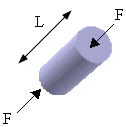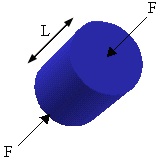

|
|
|
Force is a load which acts on an object. There are many units to measure force. Orthodontists measure force in units of grams. Many scientists measure force in units of Newtons. One Newton is equivalent to 100 grams. For the sake of the discussion that follows, all units of force will be in grams, because orthodontists measure units of grams. Pressure is the force per unit area acting on an abject. By changing the size of an object, you can have vastly different pressures created. Take for example two tubes with the same force of 100g acting on them. Tube A has a diameter of x and Tube B has a diameter of 2x. Which has the greater pressure?
Which has the greater pressure--A or B?
This should be intuitively obvious since the same amount of force acting on a smaller object should result in greater pressure. That is why boxers don't fight outside of their weight class. A smaller lightweight cannot absorb the same punch as a heavyweight. 
Last Update: August 19,1998 Please direct questions and comments about this page to appl@net.chem.unc.edu Designed in cooperation with The Shodor Education Foundation, Inc. © Copyright 1998 The University of North Carolina at Chapel Hill |



